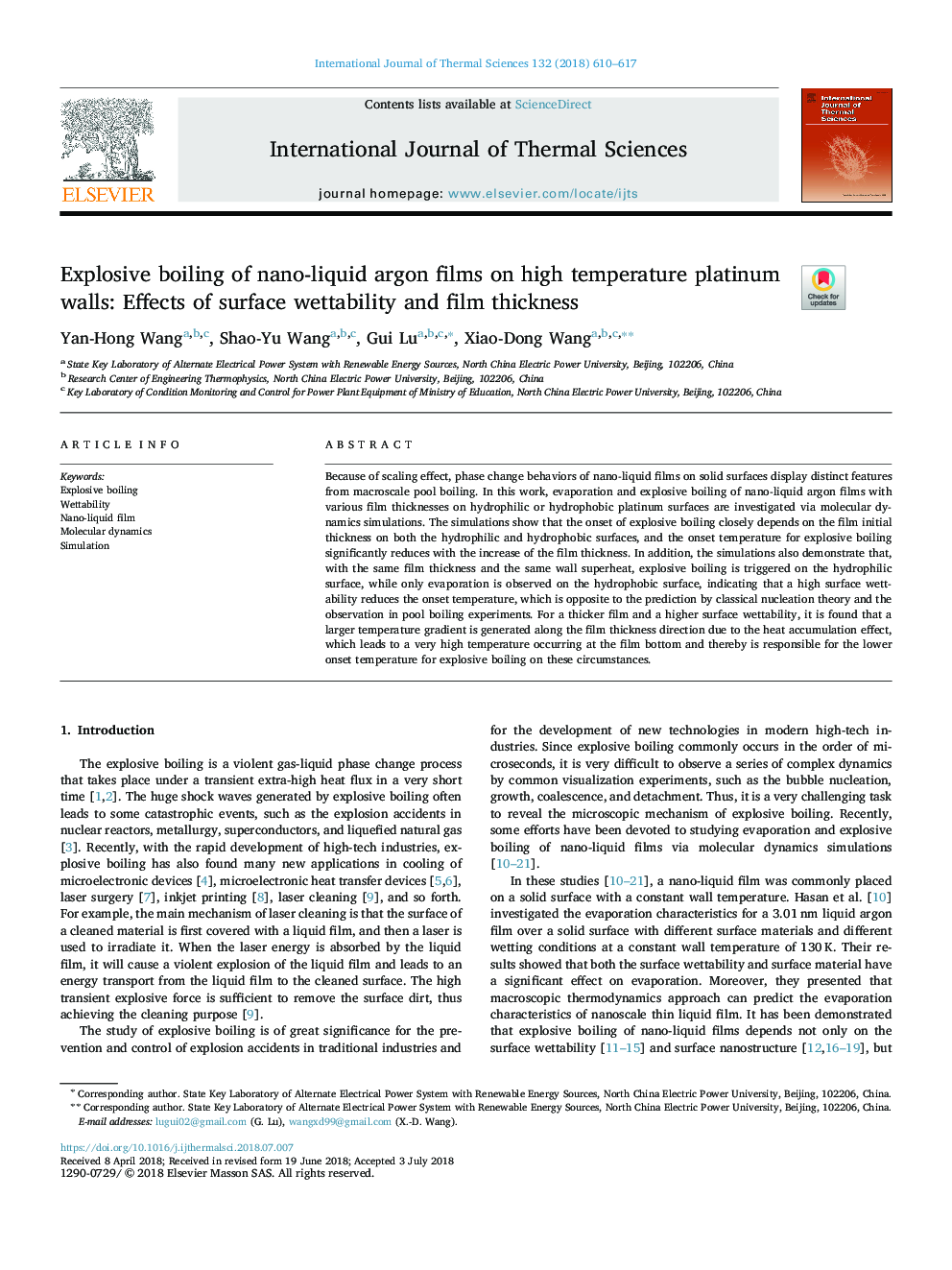| کد مقاله | کد نشریه | سال انتشار | مقاله انگلیسی | نسخه تمام متن |
|---|---|---|---|---|
| 7060652 | 1458690 | 2018 | 8 صفحه PDF | دانلود رایگان |
عنوان انگلیسی مقاله ISI
Explosive boiling of nano-liquid argon films on high temperature platinum walls: Effects of surface wettability and film thickness
ترجمه فارسی عنوان
جوش انفجاری فیلم های آرگون نانو مایع در دیواره های پلاتین با درجه حرارت بالا: اثر ترمیم و ضخامت فیلم
دانلود مقاله + سفارش ترجمه
دانلود مقاله ISI انگلیسی
رایگان برای ایرانیان
کلمات کلیدی
جوش انفجاری، رطوبت فیلم نانو مایع دینامیک مولکولی، شبیه سازی،
ترجمه چکیده
به دلیل اثر پوسته پوسته شدن، رفتار تغییر فاز فیلم های نانو مایع در سطوح جامد، ویژگی های متمایز از جوشش استریل ماکروسکال را نشان می دهد. در این کار، تبخیر و جوش انفجاری فیلم های آرگون نانو مایع با ضخامت های مختلف فیلم بر روی سطوح پلاتین هیدروفیلی و هیدروفیلی، از طریق شبیه سازی های پویایی مولکولی مورد بررسی قرار می گیرند. شبیه سازی نشان می دهد که شروع جوش انفجاری به شدت به ضخامت اولیه فیلم در هر دو سطح هیدروفیلی و هیدروفوب بستگی دارد و دمای شروع برای جوش انفجاری با افزایش ضخامت فیلم کاهش می یابد. علاوه بر این، شبیه سازی همچنین نشان می دهد که با همان ضخامت فیلم و همان سوپر گرم دیواری، جوش انفجاری بر روی سطح هیدروفیل منجر می شود، در حالی که تنها تبخیر بر روی سطح هیدروفیبل مشاهده می شود، نشان می دهد که سطح مرطوب سطح بالا باعث کاهش دمای شروع، که مخالف پیش بینی توسط نظریه هسته ای کلاسیک و مشاهده در آزمایش های استخر جوش است. برای یک فیلم ضخیم تر و مرطوب تر شدن سطح، می بینیم که گرادیان درجه حرارت بزرگتر در طول ضخامت فیلم به علت اثر انباشت گرما تولید می شود که منجر به دمای بسیار بالا در پایین صفحه می شود و درنتیجه مسئولیت آن دمای شروع پایین برای جوش انفجاری در این شرایط.
موضوعات مرتبط
مهندسی و علوم پایه
مهندسی شیمی
جریان سیال و فرایندهای انتقال
چکیده انگلیسی
Because of scaling effect, phase change behaviors of nano-liquid films on solid surfaces display distinct features from macroscale pool boiling. In this work, evaporation and explosive boiling of nano-liquid argon films with various film thicknesses on hydrophilic or hydrophobic platinum surfaces are investigated via molecular dynamics simulations. The simulations show that the onset of explosive boiling closely depends on the film initial thickness on both the hydrophilic and hydrophobic surfaces, and the onset temperature for explosive boiling significantly reduces with the increase of the film thickness. In addition, the simulations also demonstrate that, with the same film thickness and the same wall superheat, explosive boiling is triggered on the hydrophilic surface, while only evaporation is observed on the hydrophobic surface, indicating that a high surface wettability reduces the onset temperature, which is opposite to the prediction by classical nucleation theory and the observation in pool boiling experiments. For a thicker film and a higher surface wettability, it is found that a larger temperature gradient is generated along the film thickness direction due to the heat accumulation effect, which leads to a very high temperature occurring at the film bottom and thereby is responsible for the lower onset temperature for explosive boiling on these circumstances.
ناشر
Database: Elsevier - ScienceDirect (ساینس دایرکت)
Journal: International Journal of Thermal Sciences - Volume 132, October 2018, Pages 610-617
Journal: International Journal of Thermal Sciences - Volume 132, October 2018, Pages 610-617
نویسندگان
Yan-Hong Wang, Shao-Yu Wang, Gui Lu, Xiao-Dong Wang,
